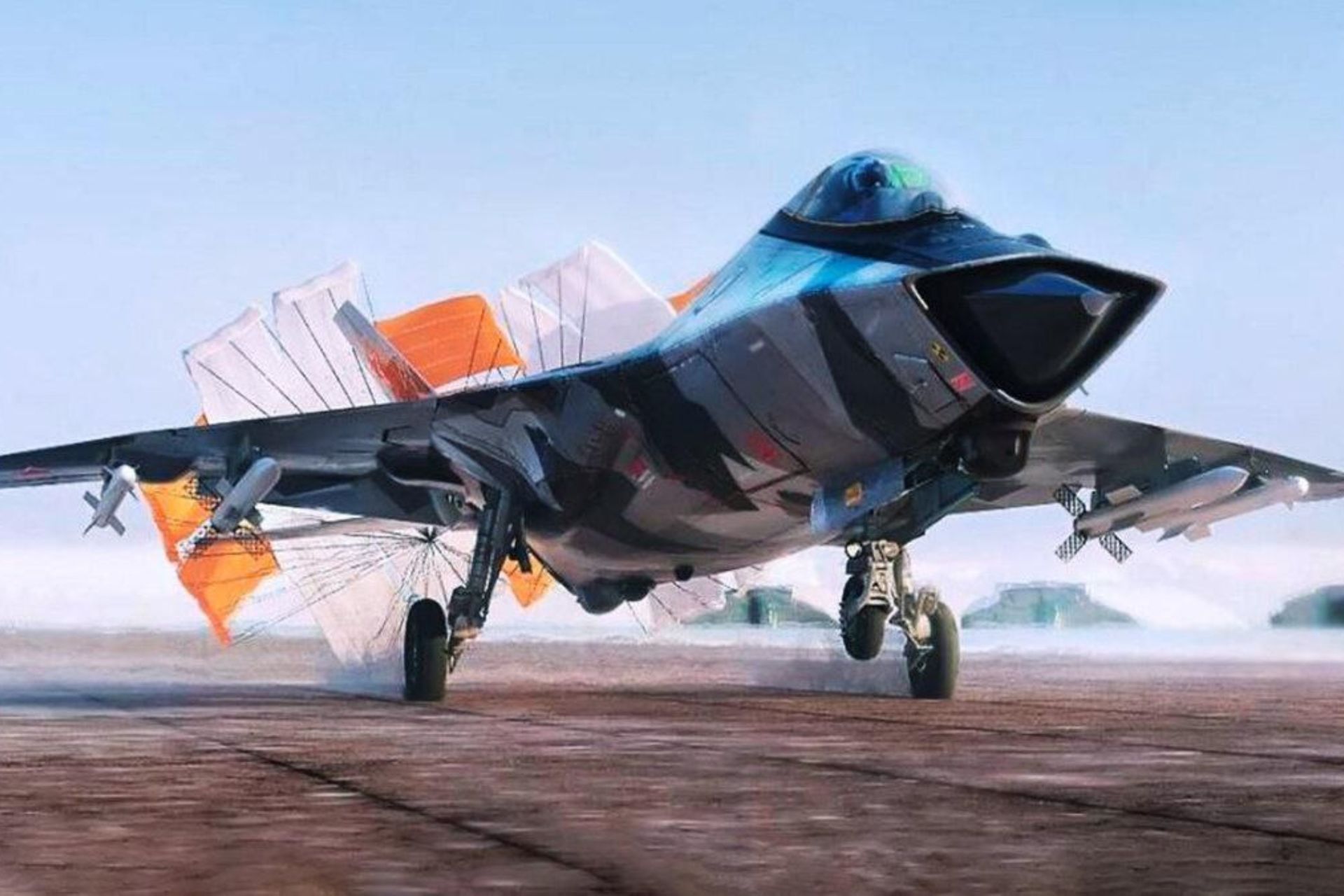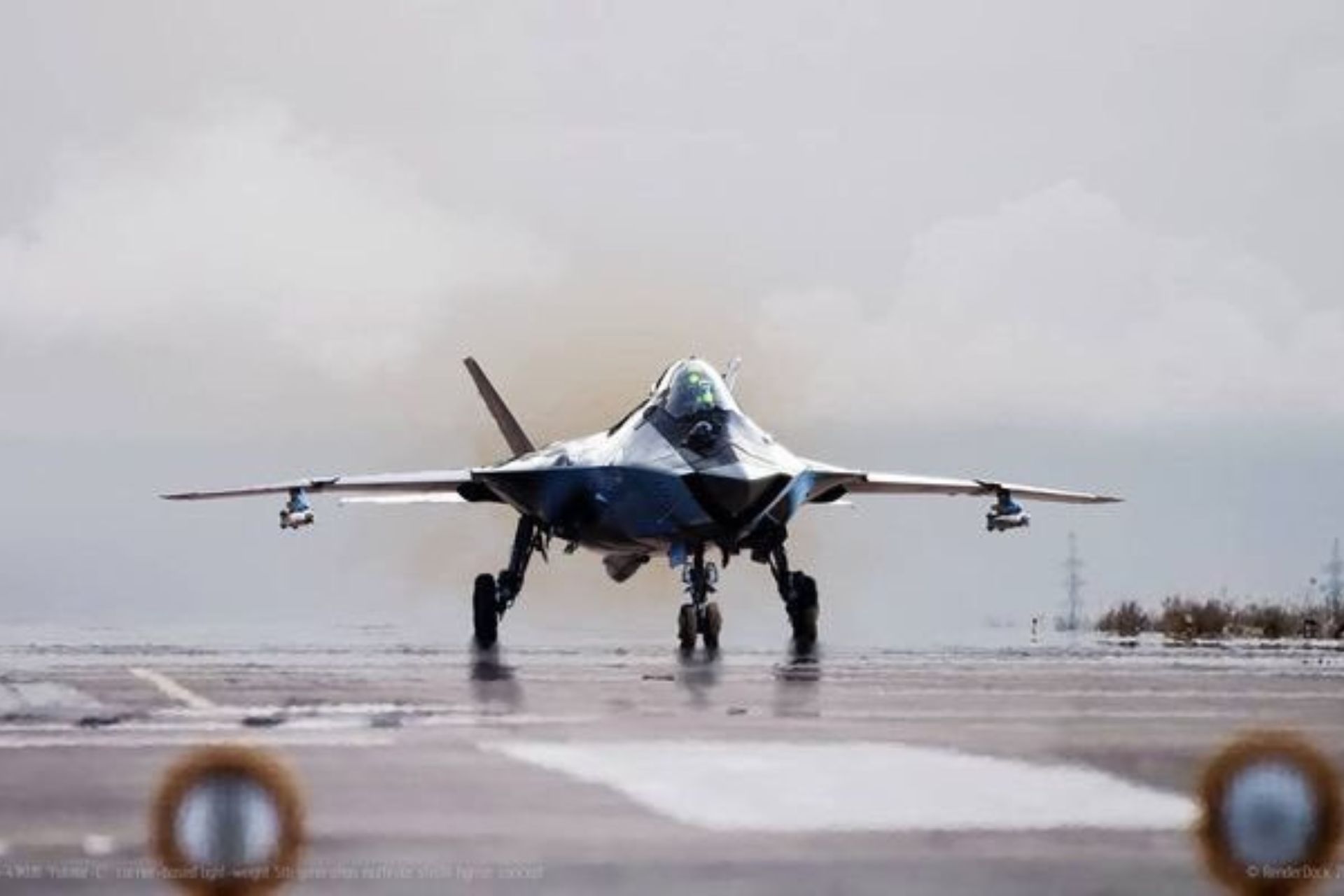Breaking News
FOCUS | Mikoyan-41 6th-gen fighter may never leave drawing board.
The MiG-41, also known as the PAK DP, is Russia's sixth-generation stealth interceptor currently under development to replace the aging MiG-31. Developed by Mikoyan, the MiG-41 aims to achieve speeds of up to Mach 4, positioning it as one of the fastest aircraft ever designed. This cutting-edge design emphasizes stealth, utilizing advanced materials and technologies to reduce radar visibility and enhance its undetectability.
Follow Army Recognition on Google News at this link

Mig-41 model 1:1 (Picture source: Rostec)
Equipped with a range of advanced systems, the MiG-41 is expected to intercept hypersonic missiles, employ anti-missile lasers, and potentially operate in near-space environments. These capabilities hint at its significant role in missile defense and space operations. Future iterations of the aircraft could even be unmanned, reflecting Russia's commitment to pioneering autonomous combat systems.
While the first prototype is expected in 2025, the MiG-41 is projected to enter service by the end of the decade. Combining extreme speed, advanced stealth, and versatile combat capabilities, the MiG-41 is poised to become an essential element of Russia's future air defense strategy.
Replacing the Iconic MiG-31K
The Russian sixth-generation Mikoyan MiG-41 fighter is intended to replace the Mikoyan MiG-31, but the technology currently appears somewhat too ambitious. The aircraft will not only operate in the upper atmosphere but also head toward lower space. It draws inspiration from the MiG-31M air dominance fighter, which is already well-established operationally.
The MiG-31 "Foxhound" had a top speed of Mach 2.83 and was equipped with a large arsenal of weapons, including six long-range R-37 missiles. The MiG-41 will embody all the advantages of the MiG-31 interceptor. The MiG-41 is expected to be a more powerful weapons platform, capable of carrying air-launched missiles like the Kinzhal and their modernized versions, with weapons likely to be carried internally. The Russians claim it will introduce features yet unknown in the aviation world. It is time to understand the characteristics and development status of this next addition to Russia's arsenal.

MIG-41 development view ( Picture Source: Rostec)
Development Status of the MiG-41
The MiG-41 PAK DP (Prospective Air Complex for Long-Range Interception) is Russia's ongoing development program aimed at creating a stealth supersonic interceptor and heavy fighter jet to replace the Mikoyan MiG-31 in the Russian Aerospace Forces by the mid-2030s. The actual designation of the platform will evolve when it enters service, integrating sixth-generation technologies and design. The PAK DP's design was reportedly finalized around the end of 2019. Ilya Tarasenko, the general director of MiG, and the head of Sukhoi, stated in a July 2020 interview that the PAK DP would be created as an advancement of the MiG-31 design.
Tarasenko also stated that it would be a new platform design capable of reaching Mach 4 and beyond, equipped with an anti-missile laser, and able to operate at very high altitudes and even in near space, flying at altitudes between the stratosphere (45 km) and the tropopause (12 km). The aircraft is also expected to borrow concepts and technologies from the MiG-31M, with an advanced Zaslon-M radar. It may use a variant of the Izdeliye 30 engines currently under development for the Su-57. The AMNTC Soyuz has disclosed information about the R-579 300 engine, already developed and a potential equivalent for the Su-57, among others.
The main challenge for the MiG-41 appears to be the continued development of the pulse detonation engine that will power the aircraft, particularly managing engine wear given the exceptionally dynamic load it will need to withstand. The PAK DP will utilize stealth technology. Russia is developing an electromagnetic pulse (EMP) cannon, which could revolutionize air combat. This innovative "energy cannon" could expand the range of achievable targets.
Russia plans to equip the MiG-41 with an electromagnetic cannon by 2025. A less powerful version of the electromagnetic cannon could be an effective deterrent against drones. The MiG-41 could also be equipped with R-37M missiles. It could later be transformed into an unmanned version. In January 2021, Rostec Corporation, the owner of Mikoyan, announced that the PAK DP had entered the development phase. The fact that the first flight is scheduled for 2025 indicates that a lot of work has already been done (or should have been done). The design should have been finalized, and metal cutting should have been underway for some time. The aircraft's propulsion and initial engine tests should be completed. If the timelines are realistic, taxiing tests should begin in 2024.
It is difficult to predict the current state of Russian aircraft due to the secrecy surrounding them. If the MiG-41 successfully makes its inaugural flight by 2025, it should be fully operational by 2030. Originally, the MiG-41's introduction into service was announced for 2028, which now seems not only unfeasible but particularly unrealistic.

Expected view of Mig-41 on take off, with two additionnal Air to Air missiles ( Picture source: X.com)
A Different Operational Concept
As an interceptor, its primary mission would be to counter future reconnaissance aircraft currently being developed by the United States and China. According to some Russian media, the PAK DP was intended to become a hypersonic missile interceptor by carrying a multifunctional long-range interceptor missile system (MPKR DP) that would distribute multiple sub-missiles to increase the chances of intercepting hypersonic weapons.
The distributor could also contain surface strike weapons. The PAK DP is also intended to carry anti-satellite lasers or missiles.
Design and Program Management Challenges
Many Western aviation analysts believe that even though details remain vague, the Russians seem to be proposing technological concepts that do not yet exist. The most advanced concept currently is the US Air Force's Next Generation Air Dominance (NGAD) fighter. China is still talking about fifth-generation fighters. Both the United States and China have allocated far more significant funds to their future programs. Russia is still struggling to complete the development and secure a decent number of Su-57 "Felon" aircraft.
The Su-75 "Checkmate" is still in its early stages. Both programs are seeking foreign partners to increase the number of their aircraft, raise funds, and amortize costs. It remains to be seen whether Russia is engaging in information warfare with the MiG-41 or if it genuinely has something up its sleeve. Russia remains engaged in Ukraine and must contend with the economic power of the West, which does not allow it to have sufficient funds. The Russian military-industrial base is also highly stressed. Today, the question arises whether the MiG-41 will receive the desired support, unlike the Su-75, which faces a shortage of buyers.
At speeds close to hypersonic, the heat generated by air friction allows sufficient stealth to be maintained without deteriorating the coating, which also presents a technological challenge. The heat generated by the exhaust could also increase its radar signature. The maintenance and repair of stealth coatings are very costly, and even the United States finds it challenging. Designing a canopy for hypersonic and stealth flight would also be a challenge.
Achieving high speeds usually involves compromising maneuverability. However, this is not an issue for this role. The use of a pulse detonation engine in the MiG-41 represents a significant technological challenge.
While promising immense power, this field is notoriously complex. Even proper development of the scramjet will not be simple. Such high speed also means very high fuel consumption, limiting range and endurance.
To increase range, more fuel would need to be carried, implying an increase in size and weight. Otherwise, in-flight refueling would be necessary for most missions. The ability to fire at high Mach numbers would require specially designed weapons.

Expected view of MIG-41 whith two seats ( Picture source: Dzen.ru)
Conclusion
On paper, the MiG-41 seems to be the miracle weapon, the aircraft that will dominate space and the atmosphere, but in reality, the ambitions seem particularly high given the low funding conditions for its development. Furthermore, it is quite uncertain whether such technologies are available in Russia in terms of costs and technological advancement.
However, there is no doubt that this development will be delayed due to the focus on Su-57 production, which is not only more realistic but also more relevant in current conflicts. Indeed, a highly mobile aircraft with enhanced stealth has a better chance today than the current fleet. Therefore, the international conflicts that Russia is currently involved in make these high ambitions less relevant and delay the development of the MiG-41.
It is likely that the MiG-41, which will be tested in 2025, will still be in the development phase, with the onboard weaponry being developed in parallel and not directly on the aircraft. Several evolutions will therefore be expected depending on this development.


























